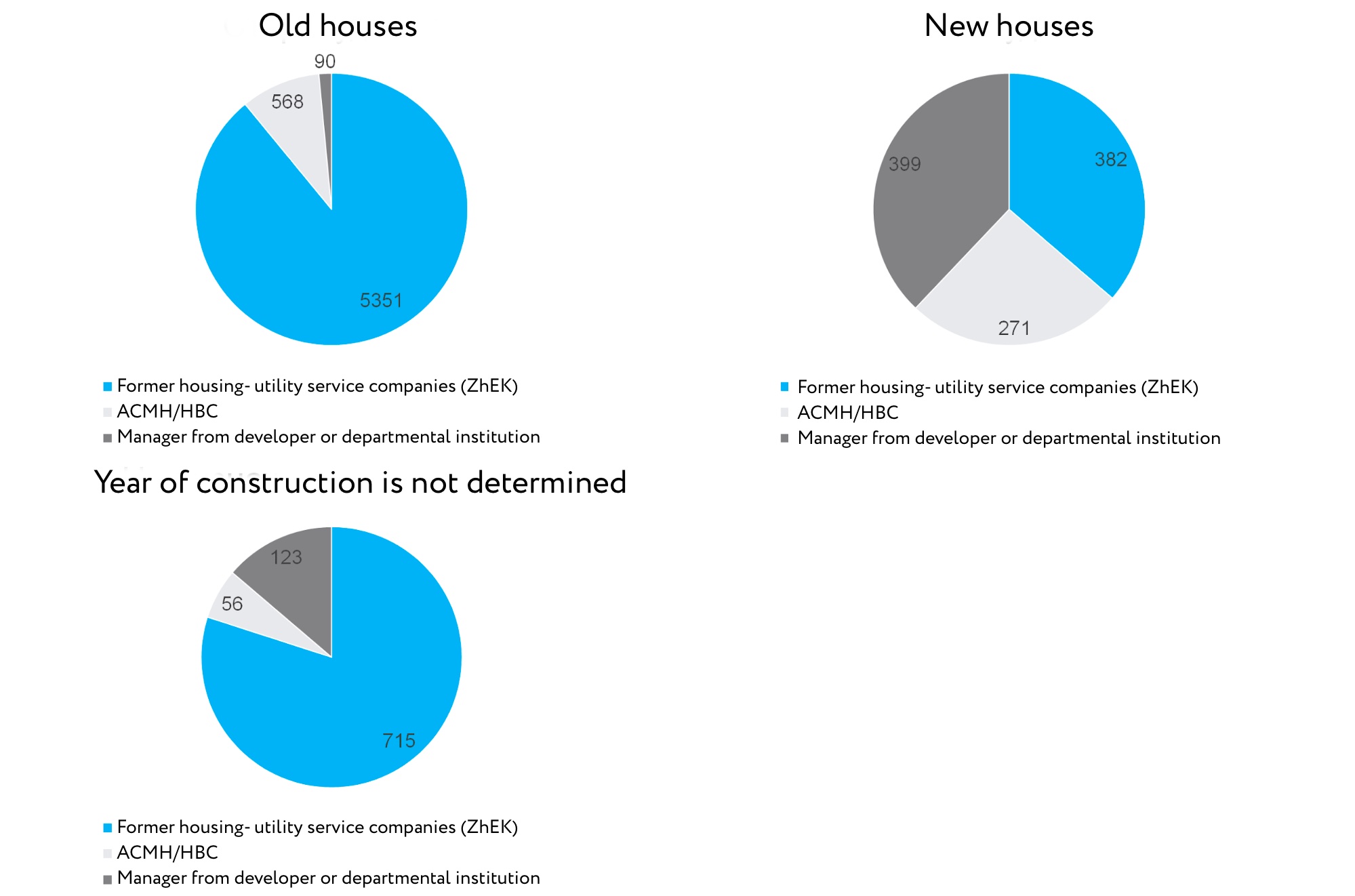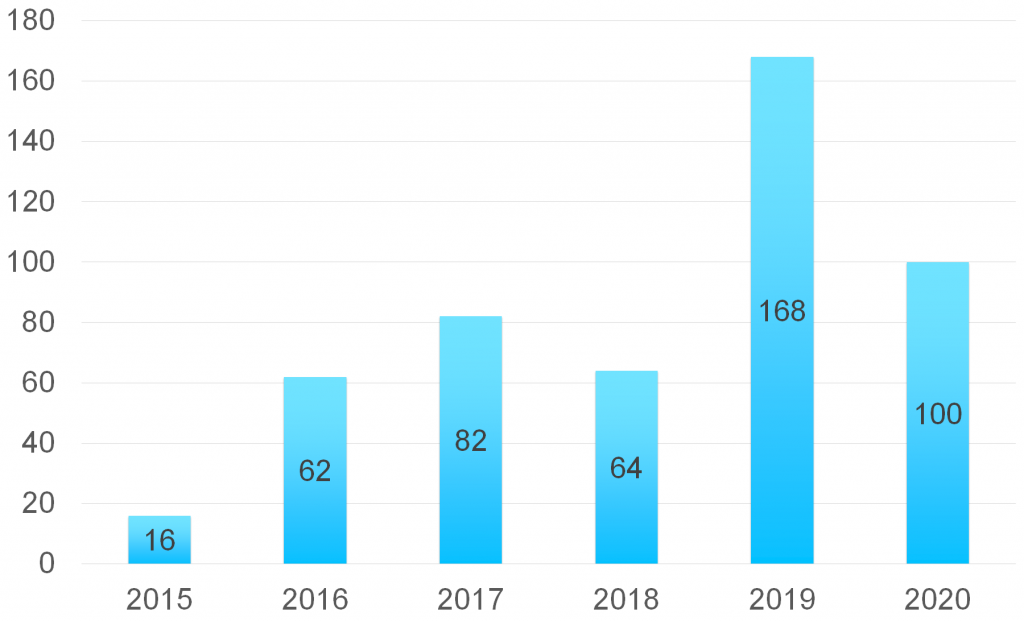Old houses (built before 1991) with condominiums (ACMH) / HBC pay for heating by 22% or 4.7 UAH / m2 less than houses without condominiums. For a year the savings in the average house is 108 thousand UAH. The corresponding savings figures for new houses (built after 1991) are 30% or 5.8 UAH / m2, which means 324 thousand UAH per year for the house. This money can be used for major repairs, new elevators, roofs, communications, etc.
We thank Anna Denysenko for help in collecting data, Iryna Sharova for help in editing the article, Andriy Sauk and Maria Osypchuk – for valuable comments.
Today, more than 80% of Ukrainians consider utility tariffs to be inflated. Our analysis shows that the cost of heating (one of the most expensive utilities) can be reduced if residents create condominiums (hereinafter – ACMH).
From the site teplo.org.ua we took information about the cost of heating in houses (UAH / m2), their heated area, the availability of meters and other indicators during the heating seasons 2018-2019 and 2019-2020. In addition, from the portal lun.ua we took data for each house about the year of its construction. The data were combined into a single database with a house address
In total, the sample contains 7957 houses with a total area of over 500 m2. The oldest residential building from our sample was built in 1835, the newest – in 2018. In total, 13% of the houses in the entire sample were built in independent Ukraine (hereinafter – new houses); 76% were built before 1991 (hereinafter – the old houses). Information on the year of construction of the remaining 11% of houses is missing. Accordingly, among the houses whose year of construction is known, 15% are new and the remaining 85% are old.
11% of houses in our sample belong to the category of ACMH (condominiums)/ HBC. Another 81% of houses are serviced by former housing -public utility services, and only 8% of houses use the services of managers from developers or departmental institutions.
Old houses are mainly serviced by utility services (former ZhEKs – housing-public utility service companies). Only 9% of old houses have ACMH / HBC.. Among new houses, the share of ACMH/HBC is higher – 26%. However, new houses are most often transferred to the management company, the “daughter” of the developer, less often – to the utility company. In our sample, the most common category for new homes is “Invest / Department” (36%) – Fig. 1.
Figure 1. Distribution of buildings by year of construction and form of management

Sources: teplo.org.ua, lun.ua, own calculations
Superficial analysis shows that usually in ACMH/HBC, regardless of the year of construction for heating pay 1.5-4.9 UAH / m2 less than in houses of other categories – Fig. 2 (more details in the appendix).
Figure 2. Median of heating costs during the heating seasons 2018-2019 and 2019-2020 in terms of different categories of houses (the difference for ACMHs is statistically significant)

Sources: teplo.org.ua, lun.ua, own calculations
For a more detailed analysis, we took into account other factors that could affect the cost of heating: the presence of the meter in the house, its type, the average monthly air temperature in Kiev, the number of heating days, and so on. A complete list of factors can be found in the appendix.
The results of the econometric model showed that in old houses with ACMH/HBC the cost of heating is lower by 22%, and in new ones – by 30%. This is approximately 4.7 UAH / m2 in the old house and 5.8 UAH / m2 in the new one.
The median heated area of the old apartment building is 3268 m2, and the new – 7991 m2. The heating season lasts 7 months. For such average houses it is possible to save for a year: in the old house 4,7 * 3268 * 7 = 108 thousand UAH, and in new – 5,8 * 7991 * 7 = 324 thousand UAH.
Why do houses with ACMH save money on heating? Some assumptions:
- – ACMHs have more control over heat consumption: on warm days in October or April, the house may refuse of heating.
- – ACMHs could install individual heating points, replace windows, balance risers or insulate walls. In this case, heat consumption will be even lower.
- – ACMH more often install a meter for heating, and its presence reduces the cost by 21% (if it is a general input meter – by 18%), because the tariff with the meter is lower (this factor is taken into account in the model. there they often reduce the price). In our sample, only 4% of houses in the category of ACMH/HBC do not have a meter. For comparison, among houses with a manager from a developer or departmental institution, 9% do not have a meter, and among houses with former housing and ultility services – 11%.
How quickly will the “ACMHs effect” become noticeable?
We considered what happened to the cost of heating in houses that created ACMH in the period from October 2018 to April 2020. Calculations showed that in new houses after changing the form of management for ACMH, the cost of heating fell by 18% compared to the previous period. This is an instant reduction in value, which in the long run reaches 30%. In the old houses there was no instant reduction in cost.
ACMHs can instantly reduce the cost of heat in new houses, as it may be easier to stop heating the house in warm weather. In older houses, the impact on cost is most likely due to insulation and installation of meters. Therefore, the long-term effect of cost reduction in ACMH/ HBC is present, but there is no immediate effect, at least in 2018-2020.
Reducing heating costs in general does not mean reducing the figures in payments (although in some houses this may be the case). The money saved can go to other costs, such as replacing the elevator, repairing the roof or basement. One way or another, for every hryvnia spent on utilities, residents of condominiums will receive more services than where there are no ACMH. Thus, ACVH are really a more effective tool for house management than housing and public utility services or other options.
Kyiv city policy to increase energy efficiency of houses
Since 2015, Kyiv has a program of co-financing energy efficiency measures in apartment buildings (hereinafter – the 70/30 program). According to it, ACMH and HBC of the city of Kyiv receive funding on a competitive basis for 70% of the cost of the project of modernization of the house, having previously carried out work on 30% of the cost of the project.
From the Kyiv City State Administration website, we took statistics on houses that won the competition in the 70/30 program in 2015-2019 (Fig. 3), and included them in our model.
Figure 3. The number of houses that won the competition of the 70/30 program in 2015-2020.

Source: KCSA
According to our calculations, the old houses that participated in the program pay 15% less than other ACMH/HBC. That is, in total such houses save 21.7 + 14.6 = 36.3%.
In the new houses that participated in the 70/30 program, the cost of heating is not statistically different from other ACMH/HBCs in the new houses. That is, the overall savings remain at 30%.
Thus, condominiums together with the co-financing program can reduce the cost of heating by about a third..
How has the cost of heating changed for houses that first participated in the 70/30 program in 2018-2019? In older houses, the cost was 16% lower than before their participation in the program. That is, the long-term effect was achieved the following year after participating in the program.
In new houses, the cost was lower by 37%. This means that the immediate effect of energy efficiency measures under the 70/30 program is strong. However, ACMH/ HBCs that do not participate in this program still typically implement energy efficiency measures, but in the long run perspective
The share of new houses participating in the 70/30 program is twice as high as among all houses in general. In our sample, 32% of the houses that took part in the 70/30 program are new (against 15% of all) and 68% are old (against 85% of all). Some houses participated in the 70/30 program, when only 5 years had passed since their construction.
Although older houses may need more renovation, residents of new houses may be more active and prone to self-organization. It turns out that the 70/30 program helps self-organized new houses to a greater extent, which can cope with energy efficiency measures without it, and old houses, which may need more help, to a lesser extent.
This, however, does not diminish the effectiveness of the program in terms of reducing the cost of heating
Government policies
Currently, some government policies do not encourage the creation of ACMH, but rather inhibit it. For example, in 2020, through a subvention for socio-economic development, funds were allocated for the overhaul of 17 houses and 8 inter-house passages in the city of Kyiv. This overhaul does not involve co-financing of residents, and in the vast majority of funded buildings there are no ACMH.
However, under the 70/30 program this year, there were not enough funds for 85 houses that applied for the competition. In our opinion, it would be more appropriate to co-finance the city program instead of financing individual houses, as the program creates incentives for self-organization of people, and co-financing encourages a more responsible attitude to the renovated house. In turn, self-organization, even at such a basic level, raises public awareness. At the same time, even a small chance to get repairs at the expense of taxpayers “with the assistance of a majority deputy” demotivates residents to create ACMH. We wrote about other defects of the subvention earlier – here, here and here. In addition to 17.5 million subventions for social economic development, in 2018. UAH 1.5 million from the State Fund for Regional Development was spent on overhauls of residential buildings.
In addition, due to the shortcomings of the law, dishonest developers can create “pocket ACMH” and manage the house without the actual consent of residents. This undermines the reputation of ACMH as a tool for home management.
Conclusions and recommendations
ACMHs reduce the cost of heating by 22% or 4.7 UAH / m2 for old houses and by 30% or 5.8 UAH / m2 – for new ones. These exepnditures can be further reduced in Kyiv with the 70/30 program. For older houses, the long-term effect of participation in the program is 15% or 2.9 UAH / m2. During the year, these hryvnias turn into quite significant amounts that can be spent on house repairs. In addition, ACMH save resources (natural gas, which most TPSs operate on), which contributes to Ukraine’s energy independence.
Therefore, these practices need to be developed. Therefore, our recommendations are as follows.
For residents of the multi apartment houses:
Create ACMH and start controlling heat consumption in the house – install meters, if they do not yet exist, consider options for insulation and overhaul of the house, including through the program 70/30.
For the Ministry of Communities and Territories Development and the Verkhovna Rada:
The ministry should refuse to fund certain small facilities, such as residential buildings. Instead, the funds of the SRDF should be directed to co-financing programs for infrastructure modernization similar to the program 70/30 in Kyiv.
In addition, it is necessary to simplify the procedure for creating ACMH. Gathering a quorum for residents at a meeting can be problematic. Therefore, it is possible to consider the mechanisms of voting at the meeting through the application DIYA (ACTION) or similar. It is also necessary to create an opportunity to register ACMH online. This requires appropriate changes in legislation and regulations.
In many buildings, the adjacent land plots need to be clearly identified, technical documentation updated and these data digitized. This will help create ACMH, as residents will have more information about their home.
The Ministry should also create a common database of apartment buildings so that sound policies can be pursued.
The Verkhovna Rada of Ukraine, in addition to simplifying the procedure for creating ACMH, needs to eliminate gaps in the legislation that allow dishonest developers to create “pocket” ACMH. This tool should help residents manage their home, not the developer’s monopoly on residents.
For Local Authorities:
At the local government level, overhaul programs should be introduced in houses with ACMH or HBCs. This is a necessary but not sufficient condition to motivate residents to create condominiums.
To help residents make major repairs to the most derelict homes, coefficients can be introduced that will favor older houses. For example, in Kyiv, the 70/30 program for old houses may look like 80/20, and for new ones – 60/40.
Communication of co-financing programs is very important. Local authorities should advertise these programs en masse. For example, information about such programs can be added to payments that come to residents every month. Such programs should be promoted on local TV channels, Youtube and other social networks. To motivate people to abandon the status quo and create ACMH, communication must be massive, powerful and long-lasting.
To expand the budget for overhaul co-financing programs, local authorities can submit these programs to SRDF project tenders instead of small projects or individual houses, which are funded annually by the fund.
Cities with apartment buildings can create sites similar to teplo.org.ua so that locals can find out which houses pay more and which pay less and why. It will also motivate residents to create condominiums. Such sites, as well as the site teplo.org.ua, should be supplemented with data on home insulation, installation of thermostats, etc., if such data are available. Such data will allow to determine which settlements are the most energy efficient and which ” take the dust “.
Appendix: methodology
To check whether the medians for ACMH/ HBC differ from the medians in other categories of house management (Figure 2), we used a nonparametric test. The medians for ACMH/ HBC are statistically significantly different from the medians for other categories for all groups of the year of construction (in all cases p-value <0.01).
In building econometric models, we took into account the following factors::
- Balance holder: ACMH or not ACMH Our main variable. Expected effect: lower prices.
– Source (TPS-5, TPS-6, HS-1, HS-2, district boilers, etc.), type of source (IHP, CHP). Different types of sources can be related to the cost of heating in different ways.
- Balance of the source (Kyivteploenergo or consumer). Different source balances can be related to the cost of heating in different ways.
- Availability of a meter. Expected effect: lower prices, as residents take into account their heat consumption.
- Type of meter (heating, common input). Expected effect: the heating meter should provide greater savings, as the general input meter partially calculates the heat from the hot water in the heating consumption.
- Heating area of the house. If there is a scale effect, the cost of heating each subsequent square meter should be less.
- The share of the heated area of the house from the total. Expected effect: lower prices. If the share of non-residential premises is small, then less heat is consumed outside the apartments.
- Number of service days per month. Expected effect: price increase.
- The share of heat consumption by legal entities. Expected dynamic model effect: price increase because legal entities have a higher tariff. On the other hand, legal entities can place more often in energy-efficient buildings to have smaller bills, so the effect is not obvious in the static model.
- Average monthly temperature. Expected effect: lower prices.
- Seasonality. In different months, houses consume different amounts of heat.
- Number of personal accounts. Expected effect: lower prices.
- Number of personal accounts with CH meters. Expected effect: lower prices.
We built a static model using Ordinary least squares method (OLS).
Since most of these variables are constant for each house, and some are constant for each month (the same for all houses), we built a dynamic model in 2 stages. In the first stage, we built an auxiliary OLS model with constant variables. These variables have a very high explanatory power (0.75), so we cannot ignore them. In the second stage, we took the residues from the auxiliary model and used them as a dependent variable in the FE model.
The main results of the models are given in Table 2. Detailed results, including all variables and the auxiliary model, can be provided upon request. All standard errors are robust standard errors.
Тable 2. Results of models
|
Dependent variable:
The average cost of providing the service per 1 m2 (logarithm). |
||
| (1) | (2) | |
| ACMH/HBC – old residential buildings [before1991] | -0.217***
(0.015) |
-0.087
(0.094) |
| ACMH/HBC – new residential buildings [after 1991] | – 0.299***
(0.026) |
-0.186*
(0.106) |
| ACMH/HBC – year of construction not determines | -0.209***
(0.026) |
|
| 70/30 program – old residential buildings [ | – 0.146***
(0.037) |
-0.158**
(0.075) |
| 70/30 program – new residential buildings [ | – 0.019
(0.059) |
-0.367**
(0.156) |
| Number of observations | 104771 | 104771 |
| R2 | 0.66 | 0.30 |
| Notes | *p<0.1; **p<0.05; ***p<0.01
(1) – Static model (2) – Dynamic model (FE), which uses residuals from the auxiliary static model as a dependent variable |
|
Attention
The authors do not work for, consult to, own shares in or receive funding from any company or organization that would benefit from this article, and have no relevant affiliations




